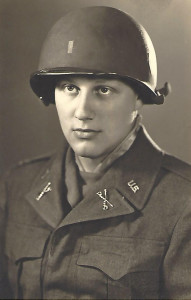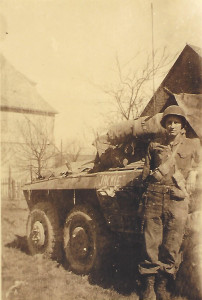
I doubt the Battle of the Bulge could take a back seat in the military career of any soldier. Being a part of this battle was the most memorable event of my military career. It came at Christmas time in 1944 and was Hitler’s final offensive of the war. After it, the Germans were on defense, fighting and withdrawing deeper into their homeland.
Hitler’s plan was to come out of the Ardennes in a swift move, break through the Allies line, turn north and capture Antwerp. This would cut off the English Army from that of the American one. The Ardennes is an area where Germany and Belgium join along the Our River. Luxembourg and Belgium are to the south, and Aachen, Germany to the north.
Somehow, Hitler thought he might take Antwerp and negotiate some kind of peace. We had our gasoline stored at Liege, one of the German’s main objectives. Hitler thought that by making such a wedge in our lines he could create another Dunkirk. The battle started on December 16. I remember most the cold and snow. The temperature was about 10 degrees above zero. We did not have air support for several days because our air force was “souped in” over in England. General Eisenhower had not expected a German offensive in this area, so many of the units there were unseasoned. One needs to understand the terrain of this area to properly imagine the battlefield. The terrain consists of forested hills, steep twisting valleys, rushing streams, and tiny quaint villages. There are few good or straight roads.
During the Battle of the Bulge, we were rushed to defend St. Vith, Belgium. I have always thought St. Vith was the most important town, even more so than Bastogne. In stopping the Germans at St Vith, we had denied them an important objective. If the Germans had a chance of success, it had to come in a lightning thrust. There was no room in their game plan for delay, and yet we stalled them.
Harrison Salisbury, writing in History of World War II, noted: “All but cut off, the Americans failed to yield St. Vith on the right shoulder of the German breakthrough. The Germans drastically needed to overrun St Vith because it guarded the Allies’ oil and gasoline supplies. In their quick strike the Nazis couldn’t carry enough fuel on their own to fight a long battle. Unable to take St Vith, the Germans finally split their force and went around, which brought them to the crossroads town of Bastogne.”
Bastogne was due west of us. The Germans encircled Bastogne and had it besieged when Patton and his Third Army arrived from the South on a dead run. But oddly it was the 101st Airborne Division, fighting a ground war, arrived first by an hour or so and beat the large German Panzer force of General Heinrich Von Luttwitz. Patton’s forces came right behind them. Later, Von Luttwitz wrote, “II still don’t understand how General Patton and the airborne leaders moved so many men and so much equipment as far as they did in no more time than they had.”

Eisenhower was quick to realize that this was a major German offensive. “Tell George to send two divisions (of his 3rd Army),” Eisenhower told Omar Bradley. At that moment, Patton was poised to strike into Germany’s coal bin, the Saar. Patton’s Army was intact, not having been shot up like the First Army, whose infantry, armor and artillery had really been hit hard. Discounting Patton, the only reserves that Ike had other than troops in England, which were too far away to be a factor, were the 82nd and 101st Airborne Divisions that were recovering from earlier fighting in camps located around Rheims. Both airborne divisions were told to move out and fight as foot soldiers. Meeting with Patton, Bradley and Jacob Devers, Eisenhower asked how soon Patton could wheel his army 90 degrees and strike north into the southern flank of the Bulge? “Two days, “Patton answered. “Sure you don’t need three?” asked Ike. “Not my style,” said Patton. ”Me and my men can do anything, even change direction. But,getting on with it is what we do best. ” With a salute, he was gone.
There are many things I recall about the Battle of the Bulge. One thing was that our Christmas presents were either lost or confiscated by the Germans. Another thing I remember is the severe cold that never rose above 10 degrees. We had fur-lined combat boots, which made your feet sweat. Often the perspiration froze and caused trench foot disease. Because my group was equipped with armored vehicles, we could remove our damp socks and dry them on warm equipment. The infantry outside did not have this luxury. Instead, they would sometimes take off their wet socks and wrap them around their waists or shoulders, hoping to get them dry. We had many cases where the nails would turn blue and then the feet white as trench foot set in. A number of men lost their toes, feet up to the ankles as a result.
Not only were we fighting seasoned German troops, but adverse weather. In hot weather, at least you usually got cool nights. But in ten-degree day temperature, the nights are even colder. The ground was frozen, so you can imagine how tough it was to dig foxholes for protection. Luckily, we had armored cars, so during the Battle of the Bulge, I recall we slept under our vehicles. But we just couldn’t get warm. And the snow! One could have made a small fortune selling sunglasses because the glare on the endless snow was unbelievable.
I really didn’t realize we had a segregated army until I got in combat. The blacks in our area were mostly in the transportation corps. This was what we called the Red Ball Express, which hauled endless loads of ammo, food, supplies, etc. Why the name? The maps were poor and printed in the metric system. So we devised a system of painting red dots on poles, trees and landmarks for them to follow. That is how the name Red Ball Express came about. There were many heroes among those black fellows driving, hauling and fighting. At St. Vith, they got out of their trucks and fought side-by-side with us.
At the Bulge we also had to worry about English-speaking German troops who dressed in captured American uniforms. They infiltrated our lines, cut phone lines, turned road signs the wrong way, directed American columns down the wrong road, and used other ruses to disrupt us. These counterfeit troops were the idea of SS Colonel Otto Skorzeny and the undertaking was designated Operation Grief .At the time, the Allies called Skorzeny “the most dangerous man in Europe”. Their activities got so bad that MPs were stopping everyone and asking them questions that they believed only real Americans would know. Two of the questions were: “How many home runs did Babe Ruth hit?” and “What’s the capital of Maryland?” A correspondent said “Baltimore” and was waved on before he could correct himself However, MPs locked up Brigadier Bruce Clark, of the 7th Armored briefly because he kept insisting the Chicago Cubs were in the American League. The German infiltrators dressed in American uniforms were eventually all captured and shot. Wearing an enemy uniform is considered spying and totally against the rules of war. Once a soldier takes off his uniform to avoid discovery, he loses his rights as a prisoner of war under the Rules of the Geneva Convention.
One tragedy of this battle was the massacre of 140 Americans at Malmedy, just up the road from St Vith. The men, all of Battery· B, 285th, Field Artillery Observation Battalion, ran into a tank column commanded by SS Colonel Joachim Peiper. Not equipped to fight, the spotters surrendered. Suddenly, several German machine guns opened up, massacring the men standing there with their hands in the air. Some of the Americans survived by feigning death.
Both Peiper and Skorzeny survived the war. Peiper was convicted of war crimes and sentenced to death, but the conviction was later commuted to life in prison. He was eventually released. Skorzeny was tried by a military court and acquitted. The massacre at Malmedy had a sobering effect on the American troops. Until that time, none of us were particularly mad at the Germans. They were doing their jobs and we were doing ours. But after Malmedy, there was a change in the attitude and behavior of our soldiers. It was hard to hold back some of our guys when they encountered prisoners.
When the Germans went on the surprise offensive even airborne troops were rushed into the breech. Private First Class Kurt Gabel of the 17th Airborne was fighting near the village of Houffalize when he saw two medics shot as they crawled forward in the snow to try and drag a wounded American to safety. Gabel, born in Germany but raised in California, was guarding a half dozen German POWs nearby when he witnessed the shooting. He promptly herded his German prisoners ahead of him at gunpoint to use as a shield while he rescued the three fallen Americans.
“That’s not in the Geneva Convention Rules, ” yelled his lieutenant from behind a fallen tree. “Neither is shooting medics, ” retorted PFC Gabel.
There was no further firing as Gabel proceeded forward. Speaking in German and holding his rifle steady, Gabel had his POWs carry the two medics and one fallen infantryman to safety.
One of my good friends was Captain Barrett Dillow, who commanded Company “C” of the 24th. He was one of the best, most fearless men I met during my time in the service. Wounded three times, he was awarded two Silver Stars, two Bronze Stars and a Distinguished Service Cross.
As we were leaving the Ardennes Forest, Barrett was shot through the stomach. He sent for me and I arrived to see him bandaged from his hips to his armpits. “You are lucky, Barrett, because they. will send you stateside to recover. By time you’re well, the war will be over, ” I told him. He gave me a wan smile, saying, “maybe, Gus, maybe.” A day or so later, I looked up from my armored car and there stood Dillow. He had gone AWOL (Absent Without Leave) from the hospital and rejoined us. “Barrett, what are you doing here? You had a ticket home, ” I said in astonishment. Dillow answered, “Gus, I had to come look after you. Those fellows on the other side are tough soldiers and mean! You are still green. ”
